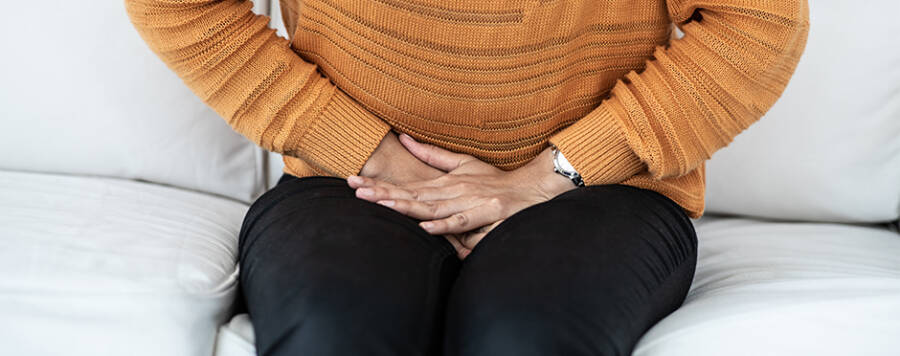If you relate to any of these scenarios, you are not alone. It is estimated that up to 12 million Americans have symptoms of a chronic inflammatory bladder syndrome called interstitial cystitis, or bladder pain syndrome (IC/ BPS).1,2 It is one of the most common pelvic pain conditions in the world, creating urinary urgency, frequency and pain. It can affect both men and women, but is more common in females.
What is the cause?
The exact cause of IC is not certain, but several theories have been proposed. One cause of IC/BPS is damage to the lining of the bladder. This protective lining normally protects the bladder wall from urine. In IC, that lining is compromised, allowing the urine to penetrate the bladder wall and irritate nerves. This perpetuates the release of histamine and creates an inflammatory response within the bladder. When the bladder is inflamed, a person experiences pain, urinary frequency and an urgency to go to the bathroom. The pain also causes the muscles surrounding the bladder to become tense. This creates pelvic floor muscle dysfunction. Another proposed cause is over-activity of the nervous system, creating hypersensitivity of the nerves that innervate the bladder and associated structures.
Interstitial cystitis often occurs in the presence of other autoimmune conditions, such as fibromyalgia, irritable bowel syndrome, vulvodynia, prostatodynia, endometriosis, anxiety and TMJ.3,4 Many of these conditions are thought to have a component of nerve hypersensitivity. IC/BPS is typically linked to some type of environmental sensitivity, trigger or allergy. Understandably, depression and anxiety often accompany IC.5,6
If left untreated, IC can drastically affect the quality of one’s life. Urinary frequency can greatly inhibit shopping, travel, sleep and work. Pelvic floor dysfunction can cause pain and difficulty with bowel movements, abnormal urination and pain with intercourse. Tight and painful muscles in the legs, abdomen, and pelvis can limit sitting and the ability to carry out work and home tasks. Many with IC cannot tolerate wearing tight clothing. Dietary restrictions can also be a factor, as many foods and beverages are not well tolerated.
Is there any help available to those who are struggling with IC?
YES! The first step is finding a doctor or physical therapist who will listen to your symptoms carefully and attentively. Most often, IC goes undiagnosed for years. Many patients have to search for a doctor or therapist that can help them. Effective therapeutic relationships with the right practitioners create a place for healing and progress. The quicker one is diagnosed, the quicker treatment can begin, and the less damage will be done.
Once a diagnosis of IC has been made, there may be many treatments that can help. First, your doctor may discuss dietary interventions, supplements, oral medications, or treatments instilled directly into your bladder to reduce your symptoms. They may also refer you to physical therapy.
The American Urological Association has identified physical therapy as a first-line treatment for those with IC/ BPS.7 Be sure to find a physical therapist (PT) in your area who specializes in men’s or women’s health. Physical therapy interventions are critical for pain reduction, patient education, bladder training, and muscle relaxation of the pelvic floor, legs, back, and abdomen. Your PT will issue a bladder diary to help you retrain your bladder and discern what foods/drinks may aggravate your symptoms. Your PT will also release trigger points associated with IC and pelvic floor dysfunction, as well as give you tips and stretches to help you minimize your symptoms at home. Your PT should also discuss avoidance of those activities which can worsen symptoms, including exercises that strengthen the abdominals and pelvic floor. They will teach you methods to relax your pelvic floor and associated muscle groups to aid with bladder emptying, bowel movements and intercourse. Most importantly, they will help you live life again!
There is hope for you if you are experiencing symptoms of IC/BPS. A good doctor/therapist team will be your guide to reducing symptoms and restoring you to better health! For more information, contact your local Athletico Pelvic Floor Physical Therapist for a free assessment, appointments are available in-clinic and virtually through a secure online video chat.
The Athletico blog is an educational resource written by Athletico employees. Athletico bloggers are licensed professionals who abide by the code of ethics outlined by their respective professional associations. The content published in blog posts represents the opinion of the individual author based on their expertise and experience. The content provided in this blog is for informational purposes only, does not constitute medical advice and should not be relied on for making personal health decisions.
References:
1. Hanno P, Burks DA, Clemens JQ et al. American Urological Association Guidelines on Interstitial Cystitis/ Bladder Pain Syndrome. Linthicum, MD: American Urological Association; 2014.
2. Berry SH et al: Prevalence of symptoms of bladder pain syndrome/ interstitial cystitis among adult females in the United States. J Urol 2011;186:540.
3. Warren JW, Howard FM, Cross RK et al: Antecedent nonbladder syndromes in case-control study of interstitial cystitis/ painful bladder syndrome. Urology. 2009;73:52.
4. Chung S, Liu S, Li C, Lin H. Bladder pain syndrome/ interstitial cystitis is associated with hyperthyroidism. PLOS One. 2013:8(8):e72284.
5. Hepner K, Watkins K, Elliott M, et al. Suicidal ideation among patients with bladder pain syndrome/ interstitial cystitis. Urology. 2012;2:280-285.
6. Watkins K., Eberhart N, Hilton L, et al. Depressive disorders and panic attacks in women with bladder pain syndrome/ interstitial cystitis: A population-based study. General Hospital Psychiatry. 2011;33(2):143-149.
7. Hanno P, Burks DA, Clemens JQ et al. American Urological Association Guidelines on Interstitial Cystitis/ Bladder Pain Syndrome. Linthicum, MD: American Urological Association; 2014.
Jovie Murtha was a physical therapist at Athletico Physical Therapy at the time of this blog.

 width="900"
height="356"
>
width="900"
height="356"
>
